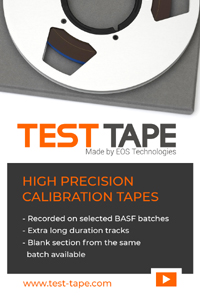Electronic Editing
No tutorial on modern videotape machines would be complete without a brief mention of editing. Without the ability to edit, the videotape machine would never have risen to the important place it occupies today.
Early videotape was edited much like film was, by splicing, except it was much more difficult. Just like film, videotape needs to be edited in just the right spot to create a breakup-free splice. Unlike film, there are no visible 'sprocket holes' to precisely align the film on a cutting block. And, you cannot see the pictures you are editing. You would start editing by viewing the two segments you wished to edit. You would physically mark the tape at the point where you wanted the splice. This was tough, as quadruplex cannot produce a still picture.
After marking the spot on the tape, you would remove the tape from the machine and take it to the editing station. There you would apply a magnetic developer commonly called 'edit vue' to the tape. This was a suspension of fine iron particles in a solvent. It made the magnetic tracks visible. Using a special microscope, you would locate the track containing a vertical sync pulse nearest your splice mark. Using a special jig, you would cut the tape between the tracks just before or after the track that contains vertical sync.(Remember, the tracks on quad tape are nearly vertical.)
You would prepare the second tape segment in a similar manner. Finally, you lined up the two pieces of tape, and taped them together with a very thin foil splicing tape. If you did everything just right and were lucky, the splice would not produce any picture disturbance when played back. If you were very unlucky that day, the splice would fail as it passed through the vacuum guide, and you would break off a video head tip! (A quad head rebuild costs at least $1800!)
This demanding procedure
This demanding procedure led to rapid work on an all electronic editing system. It became available a few years after the first tape machines. To use the electronic editor, the operator would preview the tape he wanted to add video to, or replace video on. He would record a cue tone at the 'in' and 'out' points of the edit. Then, the operator would put the machine into edit mode.
When a cue tone was detected, the machine would electronically switch to record until the second cue tone was detected. (The cue tones were recorded on the cue audio track.) Although early versions of this system required frequent alignment, it worked quite well, and was used on quad machines right up to the end of their production in the early '80's. Some consumer machines use this system today.
Some early industrial VTR's featured a fully manual electronic editing system that worked by the operator pressing buttons at just the right moment as the tape played. This was very common on EIAJ machines.
In 1972, truly easy electronic editing came to be. IVC corporation produced an easy-to-use editor for their model 900 VTR. It had just six buttons, and anyone could learn to operate it in about ten minutes. This was the beginning of 'point and shoot' or 'punch and crunch' editing found on most professional machines today.
A digital tape counter
On most helical scan machines, you can get some form of picture in still or shuttle modes. To edit, you would look at the tape you are editing, and select an 'in' point and an 'out' point using front panel buttons. A digital tape counter (On modern machines) tells you exactly where you were on the tape down to the frame. You can view the tape at any speed you need to by using a special knob called a search dial. The search dial allows you to move the tape at any speed from frame-by-frame to fast forward or rewind. This feature is present, in a crude way, on some consumer VCR's.
To edit, you just simply press a button. The tape would automatically wind to a point about 5 seconds prior to the point where the edit was to begin. This is called Preroll. The machine now goes into 'play', and the five second preroll gives the servos time to lock before the edit. At the exact time of the edit, the machine switches into record. After the edit is over, most machines preroll to a spot just before the end of the edit to get you ready for the next edit. Another button lets you review the finished edit and automatically and puts you back in the correct spot for the next edit.
If you are editing video over video, you have to leave the control track alone, so the machine's servos will not unlock when playing back the replaced portion. The old control track acts as a guide as to where to locate the new video tracks. You also don't want to erase any audio tracks you aren't editing. Since helical scan video tracks are slanted on the tape over at least several inches, you can't use a stationary head to erase the old video tracks. What is done instead is a special set of heads mounted on the video headwheel, called Flying Erase Heads erase just the video tracks. The flying erase heads are arranged to be just before the record/play heads on the headwheel.
Modern editing of this kind would not be possible without microprocessors. In fact, the modern videotape machine can contain six or more microprocessors!

